 Backend Development
Backend Development
 Python Tutorial
Python Tutorial
 Discussion on whether the range object in Python is an iterator
Discussion on whether the range object in Python is an iterator
Discussion on whether the range object in Python is an iterator
Iterator (iterator) is a lazy iterable object (lazy iterable). The range function is a lazy iterable object in Python 3. So, is range an iterator? Why.
TLNR: Range objects in Python 3 (xrange objects in Python 2) are lazy, but range objects are not iterators.
Yes , this is very confusing
When talking about iterators (iterators) and iterable objects (iterables) in Python, you are likely to hear someone repeat that range is an iterator. misunderstanding. I think this is a very serious misunderstanding. If you think that range objects are iterators, then your mental model of "how iterators work" is not clear enough. In a sense, ranges and iterators are both "lazy", but they achieve "laziness" in quite different ways.
What is an iterator
In Python, An iterable is anything you can iterate over, and an iterator is what you actually iterate over.
Iter-ables are able to be iterated over. Iter-ators are the agents that perform the iteration.
You can use the iter function to get an iterator from any iterable object:

Once you have With an iterator, the only thing you can do with it is get its next element:

If there is no more If there are too many elements, a stop iteration exception will be thrown:

##All iterators are iterable objects , meaning you can get an iterator from an iterator, so you can iterate over an iterator:

#It should be pointed out that iterators are stateful, after looping through an iterator once, if you try to loop again, it will be empty:
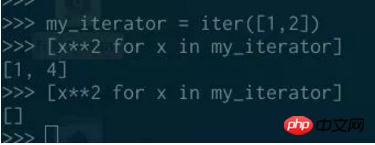
##In Python 3, enumerate, zip, reversed<span style="color: rgb(103, 103, 103);"></span> and some other built-in functions return iterators:
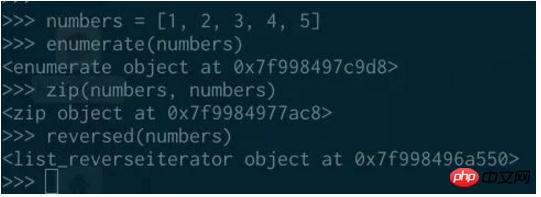
generator (whatever comes from the generator function or a generator expression) is a simple way to create an iterator:

I often say that iterators are lazy A one-time iterable object. "Lazy" because they only count items in a loop, "single-use" because once an element is "consumed" from an iterator, the element is gone forever.
What is range
The range object in Python 3 (Python 2) can be looped like any other iterable object:
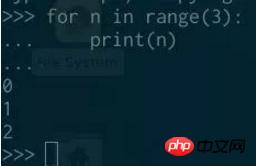
Because range is an iterable object, So you can get an iterator from it:

But the range object itself is not an iterator, we cannot call it on the range object next:

Unlike iterators, we can iterate over a range object without "consuming" it:
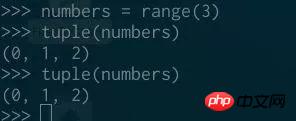
If we do this using an iterator, we won’t get any elements the second time through the loop:
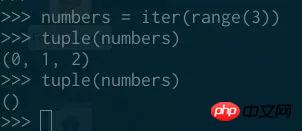
Zongshang, and <span style="color: rgb(103, 103, 103);">zip</span>, <span style="color: rgb(103, 103, 103);">enumerate</span>, or <span style="color: rgb(103, 103, 103);">generator</span> objects are different, and the range object is not an iterator.
So, what exactly is range?
The range object is in a certain It is "lazy" in the sense that it does not generate every number it contains when it is created. Instead, it returns these numbers to us when we need them in the loop.
The following is a range object and a generator (a kind of iterator):

##Unlike generators, range objects have length:
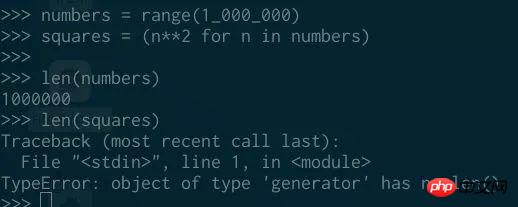
and can be indexed:

Unlike iterators, you can ask them whether they contain an element without changing their state:
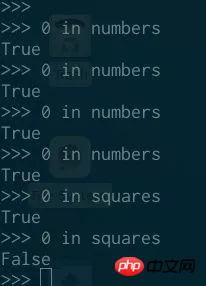
#If you want a description of range objects, you can call them <span style="color: rgb(103, 103, 103);">Lazy Sequences</span>, range is a sequence (such as list, tuple and string), but it does not contain any content in memory, but answers the question through calculation.
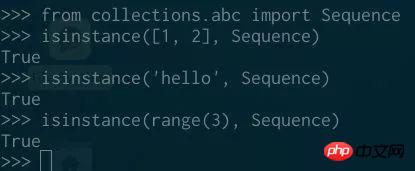
#Why this distinction is important
If I tell you that an object is an iterator, you will know that when you call the iter function on this object, you will always get the same object (by definition):

Make sure you can call the next function on this object, because the next function can be called on all iterators:
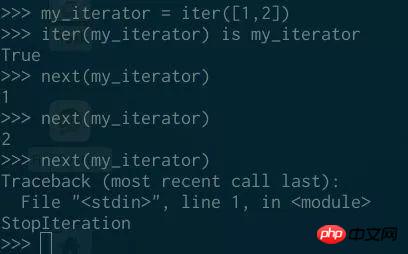
And you will know that when iterating over it, the elements will be consumed from the iterator, sometimes this feature can come in handy Usage (handling iterators in a special way):

So although it seems that "lazy iterable object" and " The difference between "iterator" is subtle, but these terms do mean different things. While "lazy iterable object" is a very general term with no specific meaning, the word "iterator" means an object with very specific behavior.
Summary
If you know you can loop over an object, it is an iterable (iterable ).
If you know that the object you are looping over is calculated while looping, then this is a lazy iterable object (lazy iterable).
If you know you can pass something to the next function, it is an iterator (which is the most common lazy iterable object).
If you can loop multiple times without "exhausting" it, it's not an iterator. If you can't pass something to the next function, then it's not an iterator. Python 3's range objects are not iterators. If you are instructing someone about range objects, please do not use the word "iterator". This is very confusing and may lead others to start abusing the word "iterator"
Related recommendations:
Detailed description of iterators
Understanding of iterable objects and iterator objects in Python
The above is the detailed content of Discussion on whether the range object in Python is an iterator. For more information, please follow other related articles on the PHP Chinese website!

Hot AI Tools

Undresser.AI Undress
AI-powered app for creating realistic nude photos

AI Clothes Remover
Online AI tool for removing clothes from photos.

Undress AI Tool
Undress images for free

Clothoff.io
AI clothes remover

Video Face Swap
Swap faces in any video effortlessly with our completely free AI face swap tool!

Hot Article

Hot Tools

Notepad++7.3.1
Easy-to-use and free code editor

SublimeText3 Chinese version
Chinese version, very easy to use

Zend Studio 13.0.1
Powerful PHP integrated development environment

Dreamweaver CS6
Visual web development tools

SublimeText3 Mac version
God-level code editing software (SublimeText3)

Hot Topics
 PHP and Python: Different Paradigms Explained
Apr 18, 2025 am 12:26 AM
PHP and Python: Different Paradigms Explained
Apr 18, 2025 am 12:26 AM
PHP is mainly procedural programming, but also supports object-oriented programming (OOP); Python supports a variety of paradigms, including OOP, functional and procedural programming. PHP is suitable for web development, and Python is suitable for a variety of applications such as data analysis and machine learning.
 Choosing Between PHP and Python: A Guide
Apr 18, 2025 am 12:24 AM
Choosing Between PHP and Python: A Guide
Apr 18, 2025 am 12:24 AM
PHP is suitable for web development and rapid prototyping, and Python is suitable for data science and machine learning. 1.PHP is used for dynamic web development, with simple syntax and suitable for rapid development. 2. Python has concise syntax, is suitable for multiple fields, and has a strong library ecosystem.
 PHP and Python: A Deep Dive into Their History
Apr 18, 2025 am 12:25 AM
PHP and Python: A Deep Dive into Their History
Apr 18, 2025 am 12:25 AM
PHP originated in 1994 and was developed by RasmusLerdorf. It was originally used to track website visitors and gradually evolved into a server-side scripting language and was widely used in web development. Python was developed by Guidovan Rossum in the late 1980s and was first released in 1991. It emphasizes code readability and simplicity, and is suitable for scientific computing, data analysis and other fields.
 Python vs. JavaScript: The Learning Curve and Ease of Use
Apr 16, 2025 am 12:12 AM
Python vs. JavaScript: The Learning Curve and Ease of Use
Apr 16, 2025 am 12:12 AM
Python is more suitable for beginners, with a smooth learning curve and concise syntax; JavaScript is suitable for front-end development, with a steep learning curve and flexible syntax. 1. Python syntax is intuitive and suitable for data science and back-end development. 2. JavaScript is flexible and widely used in front-end and server-side programming.
 How to run sublime code python
Apr 16, 2025 am 08:48 AM
How to run sublime code python
Apr 16, 2025 am 08:48 AM
To run Python code in Sublime Text, you need to install the Python plug-in first, then create a .py file and write the code, and finally press Ctrl B to run the code, and the output will be displayed in the console.
 Can vs code run in Windows 8
Apr 15, 2025 pm 07:24 PM
Can vs code run in Windows 8
Apr 15, 2025 pm 07:24 PM
VS Code can run on Windows 8, but the experience may not be great. First make sure the system has been updated to the latest patch, then download the VS Code installation package that matches the system architecture and install it as prompted. After installation, be aware that some extensions may be incompatible with Windows 8 and need to look for alternative extensions or use newer Windows systems in a virtual machine. Install the necessary extensions to check whether they work properly. Although VS Code is feasible on Windows 8, it is recommended to upgrade to a newer Windows system for a better development experience and security.
 Where to write code in vscode
Apr 15, 2025 pm 09:54 PM
Where to write code in vscode
Apr 15, 2025 pm 09:54 PM
Writing code in Visual Studio Code (VSCode) is simple and easy to use. Just install VSCode, create a project, select a language, create a file, write code, save and run it. The advantages of VSCode include cross-platform, free and open source, powerful features, rich extensions, and lightweight and fast.
 Can visual studio code be used in python
Apr 15, 2025 pm 08:18 PM
Can visual studio code be used in python
Apr 15, 2025 pm 08:18 PM
VS Code can be used to write Python and provides many features that make it an ideal tool for developing Python applications. It allows users to: install Python extensions to get functions such as code completion, syntax highlighting, and debugging. Use the debugger to track code step by step, find and fix errors. Integrate Git for version control. Use code formatting tools to maintain code consistency. Use the Linting tool to spot potential problems ahead of time.





